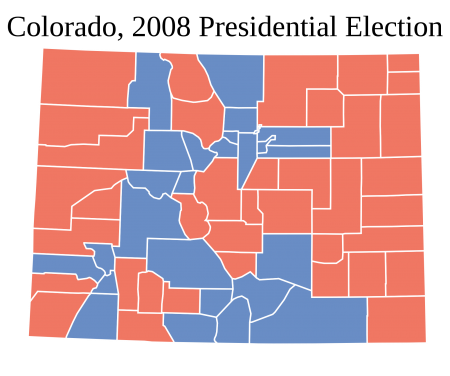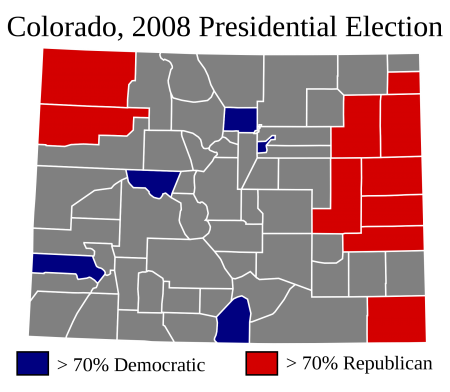This is the second part of a series of posts analyzing the swing state Colorado. It will focus on the Republican base in Colorado. The third part can be found here.
History
Once upon a time, Colorado was a loyally Democratic state. Influenced by prairie populism and anger against powerful Republican businessmen in the East Coast, the state usually voted further left than the country at large. The trend continued for seven straight presidential elections.
More below.
This ended at around 1924. Colorado voted twice against President Franklin Delano Roosevelt, and throughout the remainder of the twentieth century remained a mainstay of Rocky Mountain conservatism. As late as 2005, a Republican politician might have good reason to see this as a permanent condition.
Said politician would have been shocked to see Colorado three years later, after a massive Democratic wave. In 2008, the state voted more Democratic than the national average for the first time in ten presidential elections. And as of September 2010, Attorney General John Suthers is the only statewide Republican officeholder.
Republican Colorado
For a long time, the Republican base in Colorado really was the entire state, minus Denver and a few thinly populated Hispanic counties in the south. Almost all of Colorado voted Republican; there was little that hinted it would ever be more than a solidly Republican state.
That this has changed is fairly obvious; it is why Colorado is now a swing state. The modern Republican base in Colorado consists of two entities. To get a look at the first, let’s take a look at the counties which gave Senator John McCain his strongest support.
The counties highlighted in red are quite representative of the first part of the Republican base: rural Colorado. This description must be qualified a bit further, since some parts of rural Colorado vote fairly Democratic. The first part of Republican Colorado actually constitutes white rural Colorado, minus those parts whose main industry consists of skiing resorts (Hispanic rural Colorado is fairly Democratic, as are the parts of rural Colorado home to massive skiing resorts).
This region has quite a lot in common with other Republican-voting rural counties in the Great Plains and Mountain West. The people are generally white and poorer than the national median. They have been also voting Republican ever since the days of President Woodrow Wilson. Democrats often bemoan the loss of poor whites in places like West Virginia who once voted faithfully Democratic. But in much of rural Colorado, the white working class was never Democratic in the first place.
There is one last distinguishing characteristic of this region: it is extremely thinly populated. Indeed, in 2008 a total of 28,159 votes were cast in the highlighted counties above – about 1.2% of Colorado’s total electorate.
Thus, Republican strength in rural Colorado is a secondary force the Republican coalition:
(Note: Edited NYT Image.)
The second wing of Colorado’s Republican base is different. As the above map indicates, it can be seen in the Republican margins in the counties radiating around Denver, and especially in Colorado Springs.
These suburbs and exurbs constitute the second part of the Republican base in Colorado. Like most suburbs, they are generally wealthy, well-off places. Another distinguishing factor of Republican-leaning suburbs is their ethnicity: the reddest Republican suburbs tend to be the whitest.
Colorado Springs provides of typical example what makes a Republican suburb in Colorado. The largest red circle in the map, the city is famous as being the headquarters of a number of evangelical groups (such as James Dobson’s Focus on the Family). It also contains a substantial military population, which generally votes Republican.
The map above provides an example of Republican Colorado at a strong point. In 2000 neither party competed for Colorado, and the state went predictably and strongly Republican – as it had for decades beforehand. Republican strength in rural and suburban Colorado more than overwhelmed the Democratic-voting areas.
The next post will examine how much of Republican-voting suburban Colorado turned into swing territory.
–Inoljt, http://mypolitikal.com/


